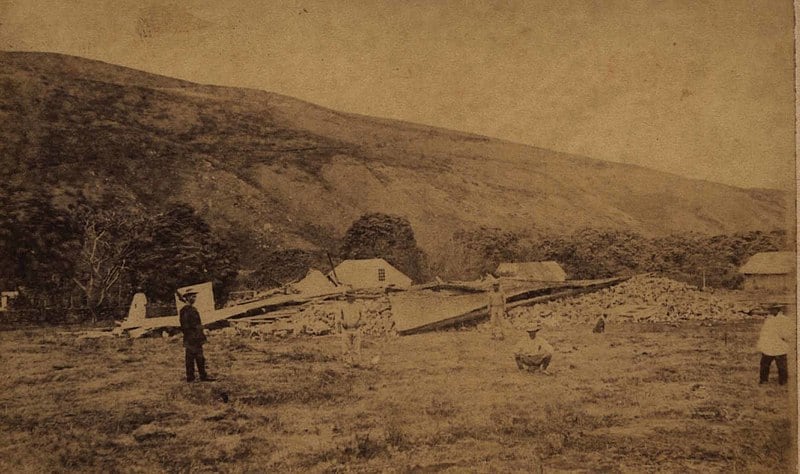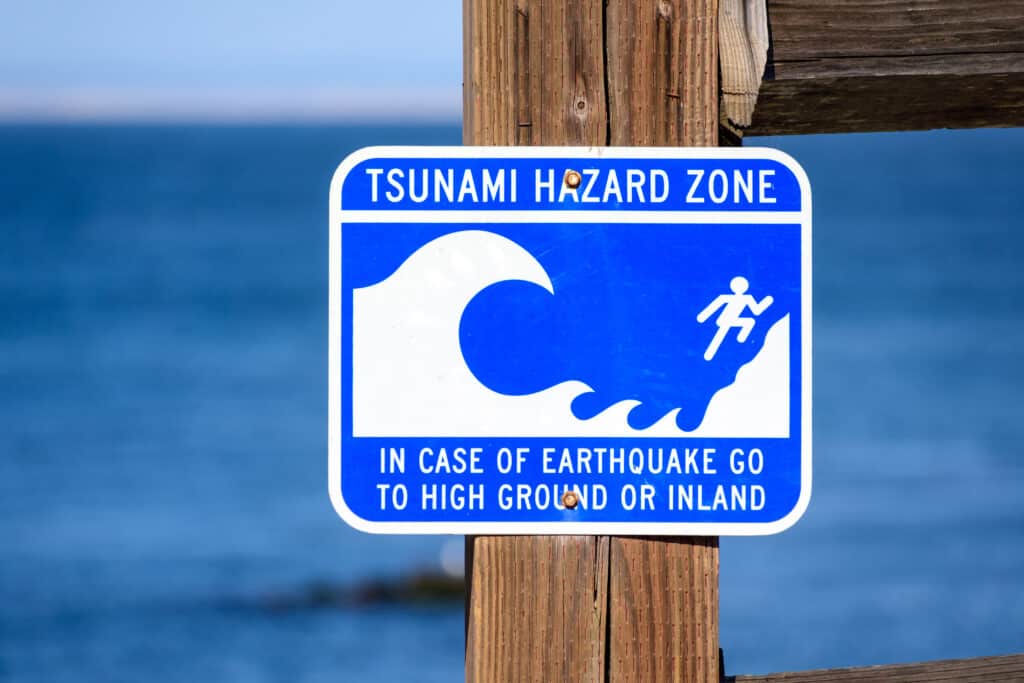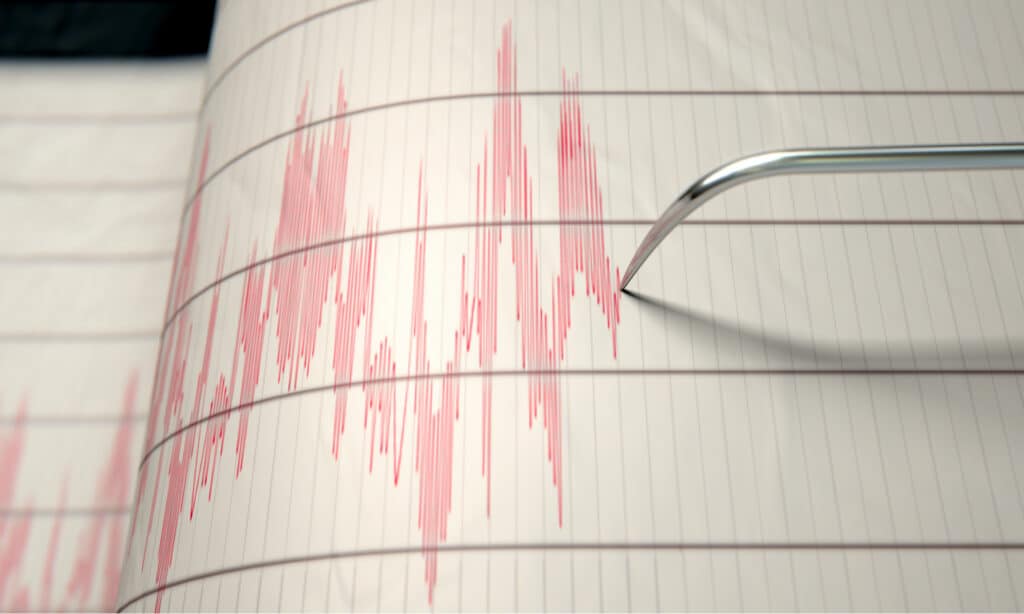Hawaii is very far from any geological fault lines. However, the island state still experiences thousands of earthquakes each year caused by volcanic processes or other structural changes caused by the islands bearing down on the Earth’s crust. Most of the quakes are weak, but a fair number of them are powerful. Today, we’re going to examine Hawaii’s most powerful earthquake ever and show you how strong it was, where it struck, the damage it caused, and more!
What Was Hawaii’s Most Powerful Earthquake?

This photo shows the ruins of the Waiohinu Church in Hawaii after the 1868 earthquake.
©Henry L. Chase / Public domain, via Wikimedia Commons – Original / License
| About the 1868 Hawaii Earthquake | |
|---|---|
| Moment Magnitude (Mw) | 7.9 Mw |
| Epicenter | 19.2°N 155.5°W |
| Date | April 2, 1868 |
| Maximum Intensity (Modified Mercalli intensity scale) | X (Extreme) |
| Casualties | 77 people (possibly more) |
Hawaii’s most powerful earthquake measured 7.9 Mw, and it struck the island state on April 2, 1968. The quake’s intensity, as measured by the Modified Mercalli intensity scale, reached X, an extreme level of damage. The earthquake created a tsunami as well as several landslides, causing dozens of fatalities.
The quake’s foreshocks started on March 27, and people reported tremors that became more powerful over the next few days. On March 28th, a 7.1 Mw quake struck the area, but the major event did not strike for a few more days on April 2nd.
The earthquake struck at about 4 p.m. on April 2nd, and numerous aftershocks followed the initial quake. The areas most affected by the quake include Pahala, Nīnole, Hilo, Kilauea, and Punaluu.
The seismic event’s epicenter occurred at 19.2°N 155.5°W, an area on the southeastern part of the Island of Hawaii called the Kaʻū district. More specifically, the region is near Pahala and the Ka’u Forest Reserve.
The Cause of the 1868 Hawaii Earthquake

Asphalt road damaged by the volcanic eruption of Kīlauea and caldera collapse with subsequent earthquakes in Hawaii Volcanoes National Park on the Big Island.
©iStock.com/hapabapa
According to the United States Geological Service, scientists developed numerous models to explain the cause of the earthquake. However, scientists still debate the root cause of this event.
One of the proposed causes is that the Kaoiki fault zone and the east rift zone of the Kilauea Volcano shifted toward the sea and created an earthquake.
Another model claims that two major landsides on the southern end of the island at the Hilina Slump caused the quake on March 27 and precipitated the events that caused the one on April 2nd. On the day of Hawaii’s most powerful earthquake, another massive landslide block on the Kilauea Volcano shifted toward the ocean, triggering the seismic event. The basal detachment occurred at a depth of 5.6 miles.
The earthquake was very powerful on its own, and it also caused landslides and a tsunami that wreaked havoc on the island and its inhabitants.
Finding the Epicenter on a Map
The earthquake’s epicenter occurred at 19.2°N 155.5°W, on the western outskirts of modern-day Pahala. This town is in the southern part of the Big Island, the Kaʻū district. That puts the epicenter less than 20 miles from Kilauea, a highly active volcano. Although the earthquake occurred on the Island of Hawaii, the effects of the earthquake were felt throughout the entire state.
How Much Damage Did the Earthquake Do to the Area?

Signs like this indicate that people should immediately go to higher ground in the event of an earthquake.
©Michael Vi/Shutterstock.com
Hawaii’s most powerful earthquake caused widespread damage throughout the region. According to reports from the Kaʻū district, the earthquake caused churches and homes to collapse, made streets split apart, and knocked people and horses off their feet.
Nearby boats reported that the quake destroyed most coastal settlements in the area. The quake also spawned a tsunami and many landslides that did even more damage to the area. The tsunami flooded areas along the southern coast of the Big Island, drowning dozens and destroying houses and other buildings.
Several landslides impacted the area, killing people and smothering all sorts of wildlife. One of the largest landslides came from Mauna Loa near Kapapala. The front of the moving earth measured almost 2 miles wide and 30 feet thick.
Homes, churches, offices, trees, and more were swept away from the area which had been devastated by the quake. As a result, places like Kilauea, Hilo, and Pahala recorded a level X or extreme level of intensity on the Modified Mercalli intensity scale. This earthquake was simply devastating.
The Casualties Caused by Hawaii’s Most Powerful Earthquake

A total of 77 people perished during the earthquake.
©Inked Pixels/Shutterstock.com
The 1868 Hawaii earthquake and its aftereffects killed 77 people and an untold number of animals on the islands. According to the existing records, landslides killed 31 people while the tsunami killed 46 people. Apparently, no individuals died during the actual earthquake. Still, a large number of people and animals perished in this powerful seismic event.
Hawaii’s most powerful earthquake was one of the most powerful to occur in the United States. In fact, it would be tied for the 14th strongest recorded in the country along with 9 other 7.9 Mw earthquakes recorded in the United States. In 1975, a 7.7 Mw quake struck the islands, causing widespread damage but killing fewer people. A quake caused by the Hilina Slump landslide, the same cause of the quakes in 1868 and 1975, occurred in 2018, showing that the threat of powerful quakes still exists in this region.
The photo featured at the top of this post is © iStock.com/CStorz
Thank you for reading! Have some feedback for us? Contact the AZ Animals editorial team.







